Erin Casali | Director of Product Design at Xero
An Event Apart Online Together – Fall Summit 2021
11:15am Central
Intro: Erin Casali is a Senior Product Design Director and coach. Over the years she has built products and help businesses transformed by trusting people and giving them agency, and by clarifying goals with a firm belief in transparency and diversity. She currently works at Zero, and was previously at Atomatic, the company behind wordpress.com ,Tumblr, jetpack, WooCommerce, and many other products.
During her 17 plus years of professional experience, she has designed consumer and enterprise products and services for millions of users worldwide in different markets. Please welcome for the first time on any An Event Apart stage, Erin Casali
_______
I give you a little background about me, not getting into details here, but just to say that I’m working in very small startups and very large organizations. I work on a product side, and I have worked on an agency side, and also had a few of my own projects, you know. This to say that, I hope that the topics, and things, I’m going to give you in this presentation should apply to whichever role you’re in. At least a certain extent. And of course, if you feel too shy to reach out today with questions, you can always reach out to me @Folletto on Twitter, and generally on all social media.
Today I want to start with reframing, a little bit about what feedback and how it works. Because there is an underlying assumption that feedback. works in a certain way. So let’s get into it.
Let’s say, for example, that you’re working with someone, and you give them feedback. And it happens that is something you notice, or maybe it’s entirely unconscious, that every time you give them feedback when they performed really well, the next time, they seem to perform worse. But at the same time, every time they don’t perform well, worse than usual, you get the feedback, they correct themselves. And the next time they perform better. The interesting thing here is not that the feedback work didn’t work, but that if we take a normal growth trajectory on a person.
People never perform exactly at the same level. So some days are better. Some days are worse, and as it happens, the best days, the next time they will be back performing at their average. On worse days, they will also be back performing at their average. But this is not because feedback did or did not work. It’s because they just go back to their own average. The feedback worked in both scenarios, it’s. just that a normal person, the average is going to be stronger than your feedback. It’s a strong, unconscious bias that comes built-in. Even if we don’t do this consciously, our brains pick up the patterns and we start thinking that negative feedback works better, but that’s not the case.
We are statistically punished for rewarding others and rewarded for punishing them. -Daniel Kahneman
So, before we move on, I also want to add another thing. When I talk about positive feedback, I don’t mean praise. I don’t mean like “good job.” The same set of standards and approaches that we use for negative feedback should be exactly the same set of standards and approaches and frameworks that we use for positive feedback. Which is not praise. It can be motivating, but feedback is not positive feedback.
Okay. So a better way to frame this, that I particularly is to say that negative feedback, or critical feedback is about change. So, you are not at the right path. Right. But what I’m telling you will allow you to go back to it. Will allow you to come back and progress again, and get better. Positive feedback at the same time is about confirmation. So it’s about. “You did well.” Let’s build on it let’s incrementally let’s go one step beyond let’s see what you can do more, but also it’s just the confirmation that among all the many infinite choices you have, you picked one that we agreed on, and we think it’s both good.
This is one of the things that is great for imposter syndrome. The confirmation that the choice was good. And now, we took a more psychological angle but there was also an analysis that looks into the data and the data confirm this. HBR’s Christine Porath’s review noticed that “high-performing teams share nearly six times more positive feedback than average teams.” So these amounts should tell you about positive feedback isn’t just the same as that negative feedback is probably even better. It’s more effective because it has all the benefits of the negative ones. Plus, it can be very motivational.
Okay, with this reframing, with this understanding of how positive feedback can work. Let’s get into it. So, what about giving feedback? We can split this into three things: content, tone, and format. Let’s start with content. So, for content, I would like to say that a particular among the many frameworks, is one that has been synthesizable. The Feedback Equation by Lara Hogan
Observation + Impact + Question = Actionable Feedback
Observation
So this idea is that if you put together observation, impact, and a good question, you can actually give good feedback. So let’s get into this. So first of all, observation. This needs to be the most, and judgmental moment of your feedback, you need to see it as if you are looking at it as a camera would look it. The situation and the design, you know, a very detached, as objective as possible as you can do. So just try to state what happened, what is the thing what is the design, what you’re observing, and then try to make your assumption explicit, right, clarify your perspective, you’re still human right. So you’re having your own perspective, and you want to bring it into the discussion and see how that works. How that complements the more objective, trying to be objective perspective. Making explicit your own assumptions, have the conversation to move on.
Impact
Then, The next factor is impact. So, if we’re talking about, for example, about a design, we could just show, for example, usability testing, you know what happened in the scenario. How they perceive it. And this will happen also in the case of a behavior. If you’re talking to someone, it is something you can say this happened. This is the impact the action had. So, regardless of design, craft or behavior, or an action, a process, you can now, after the observation, you can now say “this happened”. So don’t insert yourself in here until the last moment, it’s a little more challenging, but you can actually say, “this is how I felt,” “This is how it was” it is what summarizes this question. Laura actually says that is both a Request “please do X this way” and Question “how can we solve X?”
I’m edging more on the question side. A request is basically saying that this is what they would like for you to do. You have the expertise, you can tell them this is the preferred approach. This is a good way forward. But we have also the Question side of things. The question side of things is basically saying, “Okay, what do you think like, how do you approach this, given what I just said to you? How would you use your own expertise?” So, this is interesting because it’s basically a shift between a prescriptive way forward. So you’re stating something you want them to execute in a certain way. And on the other hand, in an open way forward, which is more suited for specialty certain kind of feedback require more creativity and more openness. So this is a really good spectrum, and I think personally that question the open side is a good baseline. But let me tell you a little story.
Story
So, a few years back, I was still working a lot on the way I was delivering feedback. I was giving feedback to others. And you know I was working with my own team, asking them to review the way it was giving feedback, how I can improve. And so, I shifted over time to an open approach, it felt more effective working for everyone in the team. It was pretty great. So, you know I got to the point of comfiness. And then I switched up teams, new people in the organization, new projects. And I realized that there was some confusion with one of the designers and I was like, okay, let’s review this. What’s the problem and they were like, well, it’s unclear to me what you mean when you say that. I have expertise and you can just tell me what to think. You don’t have to work around it. I thought, Oh that’s actually interesting, so they’re feeling that the way the open framing was not as sincere as it could be, of course, that’s not my intent. So, I just switched it back to making an explicit request with a person, and of course it doesn’t mean, that they could have a difference in perspective. They did pushback from time to time when they disagree, but in that way, it worked better for them. So I was able to fine-tune, what was the best approach.
Tone
The second part is about tone. This is something I frame it around the Receptivity Question. Mirror the feedback question. Even. if you have the best content, frame it well, you. have all the. pieces in place, if the other person is not ready to accept it, it will not go through. Timing, attitude, and Form will help you give more respectful feedback.
Timing
Be timely. Noone likes to rework. So what you want to do is to deliver your feedback on the design, when they’re working on this specific part of the design, you’re getting feedback. And this is essential. You want to be, right at the very moment, in the right process.
So, you know, the project is about to ship, you can’t restructure the entire project, unless of course there is a critical thing happening for some reason, and you really need to fix it. But, otherwise, people will just be pushed back, they just want to ship, and maybe you can work in the next piece of work. But that’s not the right timing.
The second. aspect of timing is you should communicate when things happen. This is more relevant to the person, and less about the design. Assume this is a session because you want to be as close as possible as when the discussion. So for example, if you’re talking with someone, and you want to give them feedback about the way they were presenting, you don’t want to wait too long, because otherwise, things will be forgotten. It’s more of opinions. So to be more precise.
There is a 3rd aspect of timing. You. don’t want to kill a moment. So imagine the person you were hearing presented something he landed really well. They’re super happy with the work, but you still think they. could have improved somewhere or something, because you know they have potential. You know they can grow. So allow people to enjoy this success. Unless of course, they ask for it. You can say “Let’s talk about this tomorrow.” Let’s give you some time, but not too much because you still want to be very close to the event to the situation, but at the same time, just let them enjoy that moment.
Another Story
And this is, again, another short story, how is it was working years back with one person. They said, “you know, my feedback is never listened to, I feel not listened to, I feel not valued on this team.” And so, I started talking with them, we review the work done. As a review, and you know the kind of feedback they were doing. Actually, the feedback was really good. They had a really good connection with the customers, and they were able to frame it in a good way they have really good insights. I notice that they weren’t always given that kind of insight when it was the final test in the final Q&A before shipping. And again, sure, we can talk about you know incremental shipping it shouldn’t be you know a big moment, and so on. But, you know people are people, and they just wanted to deliver. And so they rarely listen to what they were saying. The insight was not taken in. So we need to just review that and just told them, you know, let’s change the moment here. Let’s find better spots when you can do that earlier in the process, and just change that change and they were completely welcomed in the project in the process, people were happy. And, yeah, none of the team was really working in, in a solid way.
The other aspect. I really feel really strongly about it is that Rude is NOT synonymous of sincere, and more people need to listen to this. There is this general idea for some reason that you should. be tough, brutal, tell the truth just as it is. That’s just a way to say you want to be as rude as you can. That’s really No, no way around it. First, critical feedback can be that even the harshest feedback in a way that is good, constructive, and compassionate. Still difficult. But there is no reason to be rude also. That’s usually a power play a power dynamic. People are just trying to feel better for themselves do not really engage in the feedback they are giving.

And this is from a really beautiful by Kim Scott with her framework for that Radical Candor. So you want to care for me, personally, but also you want to challenge them to even to improve together.
Right. And there are also three other states, I don’t want to explain too much in detail, radical candor. But the idea right in a different way to say this is that you want, you need to get into the mindset of you just don’t want to just give them the feedback. You also want them to grow. to get better, you really want it. Right. And so if your attitude when you’re giving feedback is not just the feedback, and is the person beyond the feedback. Now we’re talking about now, you’re caring deeply about the person in front of him, and sometimes it’s difficult because you know, sometimes people are difficult. You don’t say this to everyone, but that’s what we need to strive for.
And finally, Form, and I’m not talking about Form in terms of format, but in the sense that the way we communicate, has an impact. Different people can have different ways of talking, negotiation styles differ. They could prefer feedback than in one way or another. There may be differences even across languages, and by this, I don’t mean that we’re not speaking out, English. For example, just said, if English is not your first language, then meaningful sentence structures are some things in your native language without influencing phrasing in English. That may feel sounds strange to someone else. And then there are cultural differences, then Simple as that.
And finally there are what I call Trip Words. When you say something and you notice that the mood changes and you don’t know why, and it may be just one single word. And it might be the one word and the first time it happens, it can be very quick adjustment. Say Okay, wait a second, what happened here. Okay, I will not use that word anymore. This is what I meant, and you move on.
And form is also about the fact that, literally, anything can be misinterpreted, is just an assumption we need to make. So, in a way, in our communication. We should always have at the back of our mind that is. Oh, I’m having a challenging discussion, because we disagree, actually, we disagree on the content or the deep content of the thing, or because there’s something that is making us disagree.
For example, a few weeks back I was talking with someone I was giving feedback, and they reacted strangely, and then I did a private message with them. And they were like “yeah my team, often, is in the middle of this kind of discussion. So, I’m sorry I didn’t mean to sound defensive, but I never know what angle the other person is coming from.” We clarified.
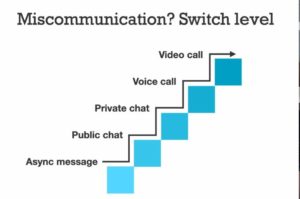
And this leads me to the next step which is, you know, miscommunication can happen. Be ready to switch the level. You have ways to tune the communication. You can start in the simplest communication and escalate. Just be aware of individual preferences so they don’t feel pressured to use a style of communication they are uncomfortable with.
Trigger Words
And sometimes, especially the form, it can be very tricky, can be very basic, especially trigger words, and it happened to me a few years back, I was working with this lovely person. And we were a few months in our working on projects together. And we were having a discussion, it wasn’t even about work, but they came out with: “Every time you start the same thing with, ‘oh’, I always feel stupid.”
I was like, “what do you mean you feel stupid? It’s just a frazzle thing I do. It doesn’t mean anything.” But to them, it felt dismissive. For months I had unintentionally been making them feel stupid. I felt really bad, but also it’s, it’s a very simple thing so correct. So, I just changed it when I was writing, I just put, you know this kind of automated rules that automatically removed “Oh”, from my writing. Things are better. This is how big Trip Words and Trigger Words can be. So yeah, this is not a big example, but I think an example can be useful here.
And finally format. So, first of all, give context. And when I say the context I’m not talking about a shit sandwich, which means starting with positive feedback and giving negative feedback and closing with the positive feedback, because that’s frankly doesn’t work. You can frame the thing right. if you’re assessing the design, say for example how you consider the overall design, how good it is, You know, the positive. It’s usually about the positive but what I’m trying to say is that this is the baseline, upon which I’m going to give you feedback. And this is important because if establishing the baseline now positive feedback becomes, this is where it started from now it’s x plus one, so we improve things, but let’s push them even further, because we can. This is good feedback I can give you to push X. And at the same time for negative like no, they can, this is bad, we need to fix it. If establishing that context, the baseline. Now, it’s more clear that it was a regression or something got worse. And now you can fix it all together, and it’s more clear on what happened and how you can improve things.
Then we have another thing that are called Depersonalized. Okay, this is very automated, so maybe tricky to do at the beginning, but it’s also very easy to do in text, which is, never say “you”. Don’t make it personal. Replace “you” for “this.” It’s always about this strategy, this design, this decision, and this applies even to behaviors, because if you help people can detach themselves, who they are, from the thing they did. It’s also easier to change the thing they did and improve it. So even in that case is not “your behavior,” but “this behavior.” And let’s review “this” together.
Then there is one thing that I feel is very simple, and probably most of designers already do this, but sometimes it happens that I see feedback that is just, you know, a whole paragraph of text that when you analyze it, and when review it is maybe basically maybe five or six different actions or different things to review. So if you want to be effective and communicate clearly, split it. Try to make it, you know, if you’re writing, this is really good because, you know, asynchronous communication is great. You write a bullet list and number it so you can actually refer out number four, and just split each action in a different item. And this, again, clarify the complications so much. Also because you can use them to review. You can also again the list and say okay, this is good. This didn’t change this and explain why, if it wasn’t already explained. This is can be super effective for everyone involved anyone listens to the discussion.
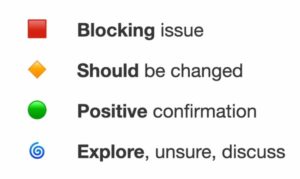 And now I want to have something a little more. Let’s say advanced, but is what they call the four emojis. So when we do this, only on teams when already establishing a higher level of trust, because it can be jarring if you get a lot of red, frankly. So I tend to itemize, and I’d like to say okay this is one is considered a blocking issue, so we should really fix this. And then we have you know the should be changing and the positive affirmation because again, positive feedback is absolutely effective, and great. And then some things that maybe are not really a change. I’m not suggesting anything, but I want to explore. I want to make a statement for discussion because we didn’t have a question. And so this is just a way to frame up my itemized list in a way that is more intuitive, because sometimes language is blurry and it happens to me a few times that you say something that you consider a blocker, and the other person thought it was just an option. And these clarify this, and probably only hire trust, because it takes a while, could feel really bad to see a lot of red, but you can give it a try.
And now I want to have something a little more. Let’s say advanced, but is what they call the four emojis. So when we do this, only on teams when already establishing a higher level of trust, because it can be jarring if you get a lot of red, frankly. So I tend to itemize, and I’d like to say okay this is one is considered a blocking issue, so we should really fix this. And then we have you know the should be changing and the positive affirmation because again, positive feedback is absolutely effective, and great. And then some things that maybe are not really a change. I’m not suggesting anything, but I want to explore. I want to make a statement for discussion because we didn’t have a question. And so this is just a way to frame up my itemized list in a way that is more intuitive, because sometimes language is blurry and it happens to me a few times that you say something that you consider a blocker, and the other person thought it was just an option. And these clarify this, and probably only hire trust, because it takes a while, could feel really bad to see a lot of red, but you can give it a try.
So, let’s flip it. Let’s go to the received part.
And it turns out you can do a lot of things in receiving that is not strictly receiving.
Question + Iteration + Review
Question: Because we want to ask for feedback. The ask should be explicit and clear. “Any feedback” is the worst possible way to ask for feedback. It’s generic and unclear. Better than not asking for feedback, yes, but it’s too open. The ask needs to be clear and specific.
It’s about the stage. In the beginning, you want an overview and then you will want more details. Stop and qualify the question. It is too generic? Avoid generics words like good, well, nice, bad, ok, and cool.
Iteration: This can be tricky because the design is always improving and being polished. I mean working in iteration post. This can be done in writing. Just give your boss the goal, give designs, logic, changes. Frame the iteration. This can be transparent. Full transparency with the whole team. Create incremental snapshots. Work doesn’t stop, but it creates a stable rhythm. It also allows to track decisions. A great way to ask for feedback. It’s about the post and the discussion.
These don’t have to be complete. Add iterations on integration. If you are stuck, you can create a post to open a discussion to see what others are doing.
Here are examples of good tools that include a blog or activity structure, link to posts, share things, comment on things, etc.
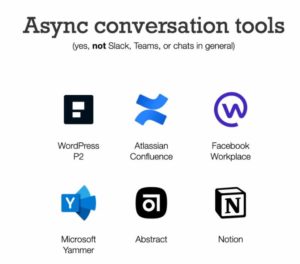
Review: First, breathe! You submitted your post. You might not have been able to be clear, but it was the best you had. Approach it like research. Apply our research skills to the results. It gives you distance. You collect information, summarize (bullet lists are good and establish common ground) and then review. There is no judgment in the first two steps. The judgment doesn’t happen until the review stage.
Remember, you don’t have to answer to everyone. You acknowledge them, but then you can work it out. Especially if you tend to be defensive. Just truly listen and acknowledge then you can work through the information. Combine that with the summery and thanking them. So acknowledging the person at this stage can be super important.
So, this is pretty much everything I had to say today and I usually like to close with a quote from Bruno Munari, a great Italian designer and educator to just invite everyone to try to make things simpler, both in your life, in your work, and the design and products, you build.
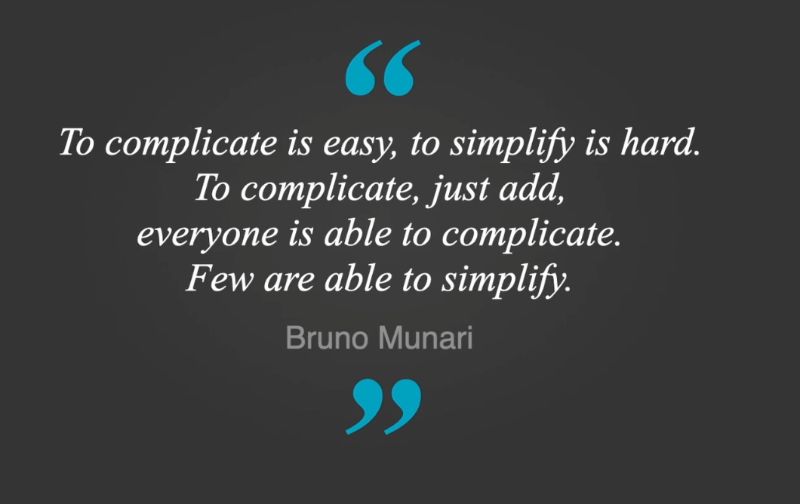
So, thank you so much for listening.
Twitter and most social media @Folletto
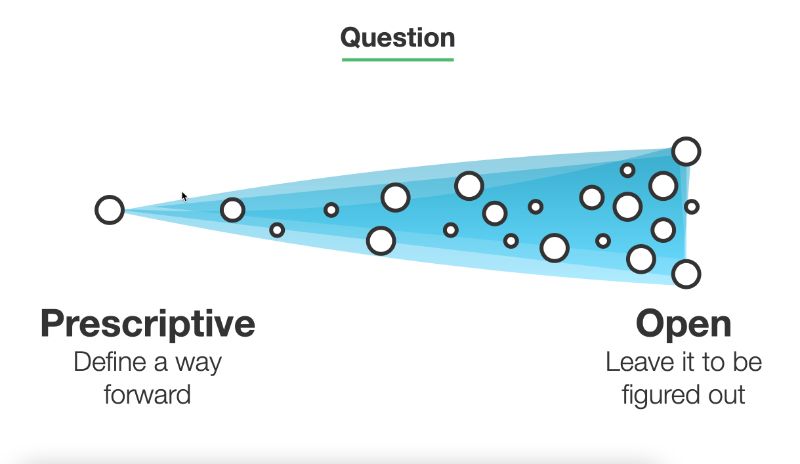






0 Comments